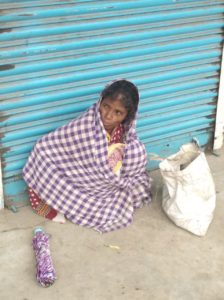Poverty is not dated. Homeless people have looked the same since the 13th century. Go back to the times of Dickens, Tolstoy and Dostoyevsky. Look at the photographs. It’s amazing. The face on a homeless person is timeless: Dustin Hoffman.
Manguli Sahoo, 82, had not eaten a morsel since the morning when we met him outside the boundary wall of the Ravenshaw College at Cuttack. We saw him on the deserted College Street, the afternoon the cyclone hit Odisha. He was hobbling with a sack slung on a small stick. He took shelter in the verandah of a shop near the College. The two small cakes were wolfed down hungrily, he wanted some tea, there was no place we could have got it from.
He was too tired and hungry for a conversation. Resting his old bones on the hard cement floor, he told us that he made a living through begging. I asked him why he did not go to the shelter which had been made for beggars by the Municipal Corporation. He mumbled something which I could not understand.
When I spoke to the person of authority the next day and told them of the one old beggar they had missed out, he informed me that they had limitations in providing shelter to all the destitute people. Asked why they were not putting him up in an old age home, he said putting up street beggars with elderly inmates in care homes was risky in the wake of Covid-19.
The elderly homeless are among the worst-hit since nationwide lockdown began. With eateries shut and strict curbs imposed on movement, hundreds of people like Manguli are left to fend for themselves. These street destitutes are at the mercy of a few NGOs and kind-hearted people who provide them food.
As per a Supreme Court directive, the government is responsible for providing shelter equipped with essential services to the urban homeless. The Indian definition of ‘homeless households’ as per the census is “households which do not live in buildings or census houses but live in the open or roadside, pavements, in hume-pipes, under flyovers and staircases, or in the open in places of worship, mandaps, railway platforms, etc.”
As per the last census held in 2011, there are 20 lakh homeless in India. Civil society organisations estimate that the actual number may well be over 3 million. Their plight does not move or bother politicians/bureaucrats, the primary reason being that none of them vote. An analysis of the measures taken by different states regarding provision of lockdown relief for the poor, issued between March 9 and May 20, 2020, shows that 16 states — with 40% of the country’s homeless — make no mention of them at all. Only Delhi, Maharashtra and Kerala talk about regular health checks and safety provisions for the homeless.
India has one of the world’s largest homeless populations, and the number has swelled exponentially during lockdown. Many day wagers have been thrown out from their hovels as they could not pay rents. Many of them wandered aimlessly, trying to find refuge at homeless shelters or lined up at free kitchens. With streets deserted, even begging was not an option. The homeless are usually fed by India’s array of religious institutions — Hindu temples, Sikh gurdwaras and mosques. But now, everything is closed; only a few gurdwaras extended help.
In a 2019 survey made on the homeless by the Indo Global Social Service Society (IGSSS), a non-profit body working on sustainable livelihood, it was found that almost 80% of the homeless belonged to Scheduled Castes, Scheduled Tribes and other backward classes, and 60% were born in the same city where they were found, indicating an intergenerational cycle of poverty.
The report figured out exactly who the homeless were and tried to unearth the various factors related to their lives — entitlements, government policies, access to shelter, violence and challenges specific to women. Almost 50% of them have no access to any sort of health services, even though 45% of the homeless live within 1 km of a hospital. As of May 28, 2020, no state has mentioned either livelihood restoration or provision of any financial assistance for the homeless in their Covid circulars.
How does one quarantine someone who has no home? The few homeless we encountered in the twin cities knew nothing about the coronavirus. They were awakened one day to find the police shooing them off the streets, ordering them to practise social distancing, the latest catchword in India, indeed the world.

Sukanti, a homeless woman who huddled in the cold wind a few metres away, had only a small bag and an umbrella as belongings. Further off, Haribaba told me that he has been stuck up since the first phase of lockdown, in the last week of March. He was from a small village near Angul, just 120 km away.
“Why don’t you go back,” I asked him. “The police are now sending people to their villages”.
He said he was waiting for his report from the SCB Medical. I assumed it was a Covid-19 test. On further questioning, I discovered that he had been referred to the cancer wing of the Katak Medical by the District Hospital, and he has been waiting for the test reports for the last two months. “I go every morning, the cancer centre does not open,” he said helplessly.
In the past eight weeks, in every speech he has made, Prime Minister Narendra Modi has stressed on the importance of staying at home. “Ghar main rahiye, ghar main rahiye, ghar main rahiye” (stay at home, stay at home, stay at home), he has repeated.
Odisha chief minister Naveen Patnaik conveyed a similar message through his video bulletins. “Ghare rahantu, surakhit rahantu (stay at home, stay safe)” he said.
The homeless have no homes? Where will they go?


